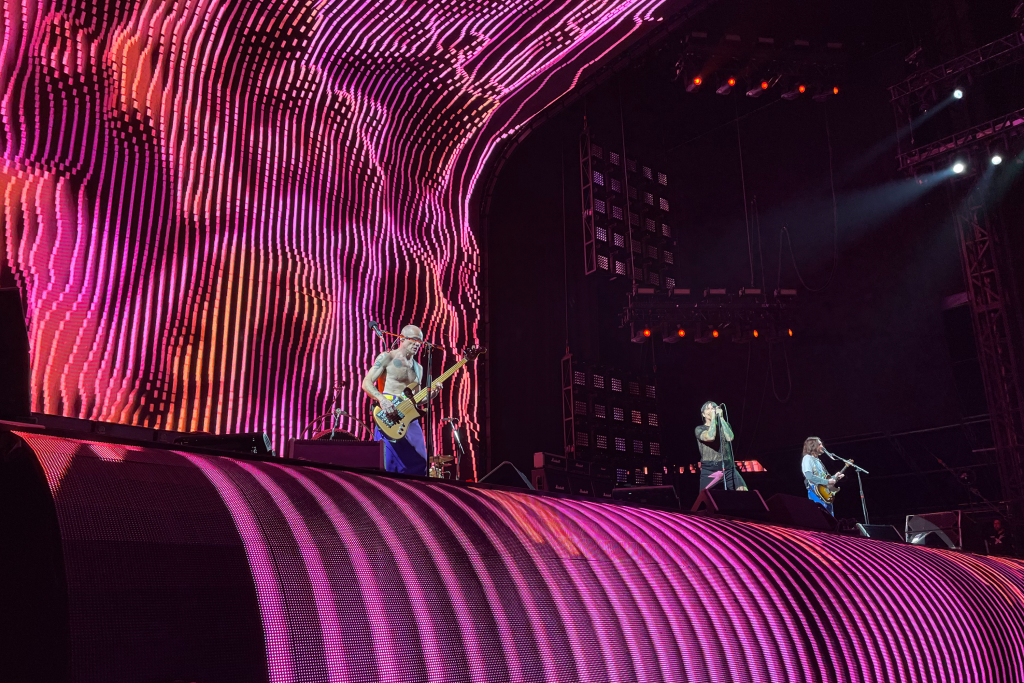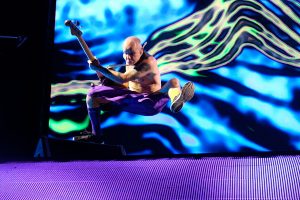Jam to jams at the JMA Wireless Dome
Jam to jams at the JMA Wireless Dome

Syracuse University’s main event space, once the Carrier Dome and now the JMA Wireless Dome, is home to some of Syracuse’s most legendary events. More than 9 million people have entered the Dome since the first football game there on September 20, 1980.
Whether they are football games, basketball and lacrosse games, commencements, concerts or Monster Jam, the Dome is the busiest college stadium in the country. In addition to public events, the Dome also hosts university activities such as drone flying, ROTC training and even classes.
In April, the Dome hosted two major events just six days apart: Monster Jam on April 8 and Red Hot Chili Peppers on April 14. The man in charge of transitioning the Dome from trucks to rock stars is Pete Sala, SU’s vice president and chief facilities officer.
On Tuesday, April 4, just a few days before Monster Jam, Sala’s team laid out a layer of plastic across the entire field. Two layers of plywood followed. The dirt arrived Wednesday morning. The trucks came on Thursday. However, Sala does not allow the vehicles to be driven into the venue, so they’re towed. The Dome is the only venue in the country where the trucks, which weigh 12,000 pounds and generate 1,500 horsepower, get towed in. With school facilities and student dorms in close proximity, the truck’s noises would cause a disturbance.
“The uniqueness of this facility is the student body. We probably wouldn’t be able to do these events like this with these changeovers,” Sala said.
In order to keep the Dome tidy, the staff covers every area in plastic: the carpeting, locker rooms, and all of the offices. Most of this work is done by Sala’s student staff members, but the other team members include Syracuse’s IATSE Union Stagehands as well as Sala’s permanent Dome employees. He runs a full-time staff of 35, a part-time staff of more than 400, and nearly 100 SU and ESF students who assist in Dome operations and facility changeovers from event to event.
SU senior Max Gelbert works alongside the student changeover crew. He said that Monster Jam took a much different route in setting up compared to previous events he’s worked.
“The literal tons of dirt covering any symbolic Dome markings around the fenced-in arena made an impact not only visually for patrons but in the atmosphere as well,” Gelbert said. “It became easy to forget they’re sitting in on a college campus. The event was otherworldly and drew in a new crowd that made Monster Jam what it was.”
Sala gauges an event’s success based on sales and a smooth behind-the-scenes experience. But Sala relies on the audience’s reaction.
“It’s smiles on people’s faces, the kids. It’s just a great event for families, and it’s again, making sure that everybody has a good time and everybody’s safe. Safety is our number one concern. We want everybody to have a good time,” Sala said.
Syracuse senior Deena Natz attended both Monster Jam and the Red Hot Chili Peppers show. She liked the chaotic atmosphere of Monster Jam, including acrobatic trucks and trucks on fire. She used a QR code system set up for fans to vote for her favorite monster truck.
“Monster Jam was super cool. It was truly the opposite of the Chili Peppers, so I have no clue how they managed to turn it around so fast,” Natz said.
Even while working on Monster Jam, Sala coordinated other SU events such as University Union’s annual Block Party, commencement for graduation, spring receptions and potential playoff lacrosse games.
“I’m not thinking about Monster Jam. We’ve had Chili Pepper meetings all day,” Sala said in an interview prior to Monster Jam.
Video clips from the setup for Monster Jam and Red Hot Chili Peppers concert in April.
By 6 a.m. on the day after Monster Jam, 90% of the original field was back. Everything was taken down; all of the seats were washed and the building cleaned. By Monday morning, the flooring cover for the concert was laid down, and the Chili Peppers’ tractor-trailer arrived with the band’s traveling staging.
“Tuesday it all really started taking shape where cranes, forklifts and the tractor trailers arrive. Tuesday and Wednesday are when the stage was built, and then Wednesday evening is when they started pre-rigging the concert,” Sala said.
Aside from the Red Hot Chili Peppers’ own team, Sala had his staff work on everything. He marked out the floor for trucks to enter and planned out the set-up of the stage two weeks prior to the show. The Dome maximized the number of attendees, and by adding more available seats, more strategic planning needed to occur. He opened up seats on both sides of the stage to pack in more music fans, even with restricted views.
Sala has been at the Dome long enough to see audio innovation change a band’s setup. Staring up into the Dome, speakers hung from all around. In the past, the speakers would be stacked from the ground to as high as the top of the stage backdrop screen.
“Those days are gone. Bigger is not better. It’s fewer speakers that are better speakers,” Sala said.
There were multiple groups of people running audio and video for the three different acts performing in the show, including openers King Princess and The Strokes. Sala had his team sync all the sounds and lights throughout the building.
Sala had a free-rigging call on Wednesday where 16 riggers put the chain motors, which hang the video and the sound, on the roof. They were all remote-controlled in order to be synced. The stage had a curved video wall as the backdrop. Between the sound, video and LED lights, the Dome uses a lot of electricity, but less than it used to.
“It’s amazing. Twenty years ago, it would take four times the amount of power that we have powering right now, what they need,” Sala said. “We’re one of the few venues in the country that has enough power around the venue floor to not have to run a generator.”
Four days before the concert, Sala stayed in the Dome till nearly midnight. Like he always does, Sala laid out the downstage and upstage edges to ensure that the stage is completely centered. He does all of the measurings and marks the floors himself, laying out everything for his staff. Once the staging, lights, sound, video, and seating layout were completed, the venue was ready to go.
Red Hot Chili Peppers, composed of Anthony Kiedis, Flea, Chad Smith and John Frusciante, made their way to Syracuse after a day off in New York City. The band’s trailers came to Syracuse from Minneapolis, the site of the previous stop on the tour. On top of the trailers designated specifically for the Chili Peppers, openers King Princess and The Strokes had additional trailer trucks.
The Chili Peppers’ touring stage took over the entire end width of what would be the football field, big enough for 30,000 fans to see. The stage backdrop was not only behind the band but circulated into the bottom half of the stage creating a flow of transcendental visuals with their trippy album theme. Performing 15 songs with two encore songs, the show ran from 6:30 to 11 p.m.
SU senior Cat Cohen attended the show last minute after buying cheaper resale tickets. Cohen has been to the Dome for several sporting events as well as concerts.
“It was much easier to get into the stadium for a concert compared to a game. I had been to the Dome before for Elton John, and I think it’s such a good concert venue,” Cohen said. “The concert was actually amazing and I had a great view of the stage. The people running the event were also super helpful.”
In the days after the concert, Red Hot Chili Peppers songs like “Scar Tissue” and “Under the Bridge” blasted from students’ houses. Back at the Dome, Pete Sala was at work. Bruce Springsteen is coming in September.








